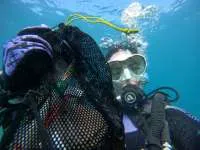
With over 5,000 dives under her belt, Ocean Angel spent many happy years as a professional Master Scuba Instructor but couldn't help notice the amount of trash steadily building up so, in 2023 she retired from teaching so she could focus on removing all the trash from the sea floor in the waters surrounding Tenerife, Canary Islands. With the successful removal of over a thousand kilos of trash from the sea in 2023, an even bigger target of 3,000 kilos was set and achieved in 2024. Ocean Angel's incredible love and passion for wildlife and commitment towards marine conservation are unwavering, with future plans to broaden her ocean trash removals to areas further afield.

When she is not diving for trash, she can often be found participating in beach cleanups and raising awareness for ocean advocacy. Ocean Angel regularly attends conservation events and forums and has been featured on several local radio stations"
Seven ways we can all help the ocean
![]() Conserving water
Conserving water
We can reduce excess water waste by switching off taps when not in use, taking showers instead of baths, only boiling what we need in the kettle, fixing and reporting leaks, and only putting the washing machine on when it is full. All these tips can help reduce water consumption and help lower your bills too!
![]() Reducing pollutants.
Reducing pollutants.
Where possible, opt for non-toxic chemicals that are not harmful to marine life and dispose of all chemicals correctly. Look for reef-friendly logos on sunscreen products that do not contain ingredients that can harm reefs, coral beds and other marine habitats. Be mindful of what you flush!
![]() Reducing waste.
Reducing waste.
Get creative by upcycling old items, recycling, and choosing products with less excessive packaging. Shop wisely with reusable non-plastic bags, such as canvas or paper and refuse single-use plastics such as straws and utensils.
![]() Seafood.
Seafood.
Choose sustainable and responsibly sourced seafood such as wild or line caught over habitat destroying methods such as super trawling and deep-sea dredging that kill millions of whales, dolphins, sharks and turtles each year through bycatch and discarded super nets.
![]() Fishing.
Fishing.
Follow catch and release practices to help keep more fish alive. Be aware of endangered species and nursery grounds in your area. Practice safe boating, such as the use of mooring buoys instead of anchoring over coral reefs and seagrass. Adhere to No Take Zones and Marine Protected Areas.
![]() Respect Ocean Habitats.
Respect Ocean Habitats.
Follow simple suggestions such as look but do not touch marine life. Be careful where you put your hands and feet. Get active and meet new friends while participating in river and beach cleanups in your local area. These can often be found on social media event pages in your local area.
![]() Take your trash with you when visiting the beach.
Take your trash with you when visiting the beach.
Dispose of your rubbish correctly and leave only footprints behind when you visit the coast. In addition to these, choose cruelty-free products and actively avoid items such as cosmetics and sunscreens that are harmful to our reefs and jewellery made from coral, shells, and shark teeth. Make a stand to boycott shark fin and turtle soup, as these are sadly responsible for the inhumane slaughtering of millions of sharks and turtles each year. Sharks play an essential role in the ecosystems of healthy oceans and desperately need our protection. Rescuing the ocean may feel like a monumental task, but if we all do our bit, we can make a massive difference.
About Tenerife
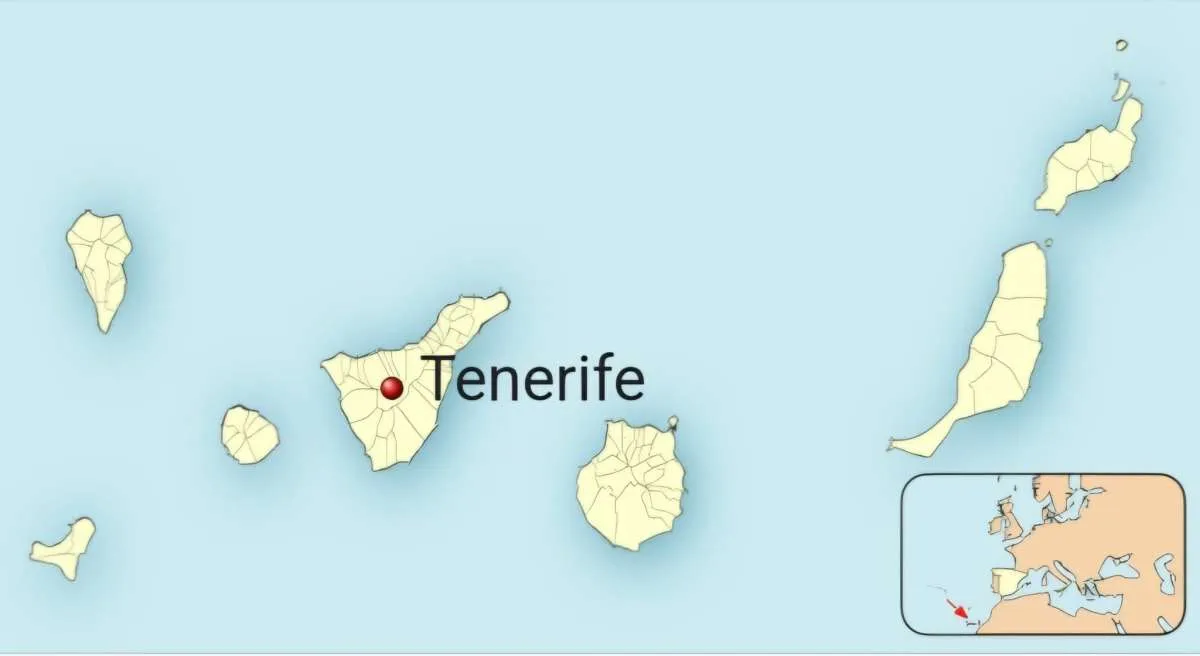
Tenerife, the largest and most populous island in the Canary Islands, is a destination that effortlessly blends natural wonder, rich history, and modern allure. Located just 178 nautical miles off the northwest coast of Africa, this volcanic island is a world-class getaway for travellers from across the globe.
At the heart of Tenerife lies Teide National Park, a UNESCO World Heritage Site and home to Mount Teide, Spain’s highest peak, rising to 3,718 meters (12,188 feet). This active volcano, which last erupted in 1909, shapes much of the island’s dramatic landscape and serves as a central figure in its geological and cultural identity.
Formed around three million years ago, Tenerife has a year-round sunny climate, stunning scenery, and golden beaches make it a magnet for tourists, and the surrounding waters are equally remarkable.
The island benefits from the Canary Current, which is part of a larger oceanic system connecting to the North Equatorial Current, the Gulf Stream, and the North Atlantic Current. This marine environment supports a rich diversity of sea life, making Tenerife an excellent spot for dolphin and whale watching, diving, and environmental conservation.
In recognition of its pristine coastline, Tenerife was awarded 17 Blue Flag beaches in 2024, celebrating its commitment to clean, safe, and sustainable seaside tourism. These efforts are part of a broader shift toward eco-tourism, with a growing number of initiatives promoting responsible travel, conservation, and environmental education.
Local organisations and marine research centres are actively involved in protecting Tenerife’s marine ecosystems, including endangered species like the loggerhead turtle and resident pilot whales. Visitors can join eco-friendly boat tours that adhere to strict guidelines to minimise human impact on marine life.
On land, guided hikes and nature experiences offer tourists a chance to explore the island’s unique volcanic terrain and endemic flora while supporting conservation efforts.
Whether you’re a nature lover, sun-seeker, or eco-conscious traveller, Tenerife offers something extraordinary for everyone. With its unique blend of natural beauty, sustainable tourism, and cultural heritage, it’s no wonder this island continues to enchant millions each year, while taking steps to preserve its magic for generations to come.
Life in the waters around the Canary Islands
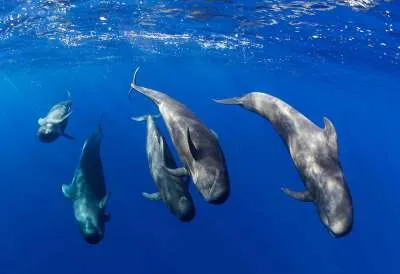 There are more than 17 species of whales and dolphins in the waters surrounding Tenerife, with Pilot Whales (Globicephala) and Bottlenose Dolphins (Tursiops Truncatus) being the most common, and you don't need to go too far from the coastline to see them.
There are more than 17 species of whales and dolphins in the waters surrounding Tenerife, with Pilot Whales (Globicephala) and Bottlenose Dolphins (Tursiops Truncatus) being the most common, and you don't need to go too far from the coastline to see them.
A short boat ride will take you along the beautiful coastline of Tenerife and provide wonderful encounters with these highly intelligent and magnificent mammals.
This is the only way to see this beautiful creature swimming wild and free with their pods in the ocean where they belong. Captive whale and dolphin shows are not only considered cruel and abusive but are now highly condemned and widely recognised as inhumane.
Be sure to book your trip with a vessel carrying the yellow flag “blue boat” logo, as only these companies have complied with the regulations and legislation necessary to protect the cetaceans in our waters.
Green Turtle (Chelonia Mydas): The Green Turtle can grow over a meter in length and can weigh over 200kg. This species is sadly on the official endangered list.
Loggerhead Turtle (Caretta Caretta): This is the second most common turtle found in Canarian waters and is also listed as endangered. It has a reddish-brown shell with strong, powerful jaws. It can live for up to 80 years and can grow up to 4 feet in length and weigh up to 400 pounds!
Angel Shark (Squatina Squatina): Angel Sharks are classed as critically endangered, but fortunately for us, they are a common sighting here in the Canary Islands, especially in the winter months. They have flattened bodies and prefer sandy bottoms where they are well camouflaged. They are generally harmless to humans.
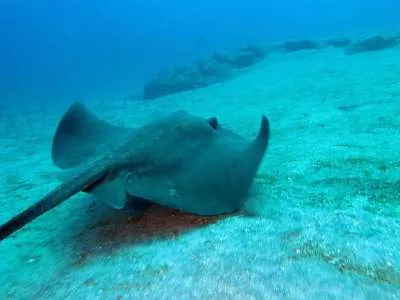
Stingray (Dasyatis Dastinaca): Stingrays dwell on sandy bottoms. They feed mainly on crustaceans and can grow a meter in length. They can often be seen in large groups during the mating season.
Eagle Ray (Myliobatis Aquila): With its distinctive spots and fins that flap like wings, these beautiful rays can grow to a staggering 3 meters across and live to 25 years and more.
Bull Ray (Pteromylaeus Bovines): Similar to the Eagle Ray, the Bull Ray can grow up to 150cm and has beautiful Tiger-like stripes on its back.
Marbled Electric Ray (Torpedo Marmorata): The majestic Marbled Electric Ray likes rocky reefs and sea grass beds. It is capable of producing 80 volts of electricity to stun its prey!
Giant Butterfly Ray (Gymnura Altavela): This species of Ray is sadly critically endangered. Sightings are rare, but they are here, nevertheless. They can grow to an impressive 2 meters in length and are harmless to humans.
Black Moray Eel (Muraena Augusti): Black Moray Eels can grow up to an impressive 5 feet in length. They have very poor eyesight, and so they rely on their keen sense of smell for hunting.
Fangtooth Moray (Enchelycore Anatina): The Fangtooth Moray are highly intelligent creatures. Their bodies are covered in slime, and they have razor-sharp, glass-like teeth, making them a formidable predator.
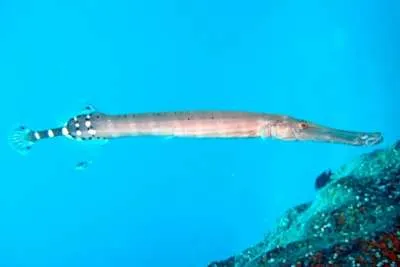 Trumpet Fish (Aulostomus Strigosus): With their elongated bodies, these graceful fish glide over the reef searching for food. They are a common sighting for divers here in Tenerife.
Trumpet Fish (Aulostomus Strigosus): With their elongated bodies, these graceful fish glide over the reef searching for food. They are a common sighting for divers here in Tenerife.
Common Octopus (Octopus Vulgaris): Did you know Octopuses have three hearts, nine brains and blue blood? They are highly intelligent and can change colour to blend in with their surroundings.
Squid (Loligo Vulgaris): Squid have 8 arms and are a relative of the Giant Squid, which can exceed twelve meters in length, making them the world's largest invertebrate.
Cuttlefish (Sepia Officinalis): Commonly spotted in our waters; Cuttlefish are masters of disguise, even though they are actually in fact completely colourblind!
Barracuda (Sphyraena): Barracuda can grow up to an impressive 6 feet in length. They have been around for over 50 million years and are capable of swimming in excess of 25 miles per hour!
Canary Damsel Fish (Abudefduf Luridus): These small but colourful reef fish are in abundance in Tenerife and live alongside their neighbour, the Ornate Wrasse. They are very inquisitive and have striking flashes of Violet along their fins and body.
Ornate Wrasse (Thalassoma Pavo): Brightly painted with all the colours of the rainbow, these pretty fish are found in great numbers on our reefs and are not afraid to check out what the divers are up to!
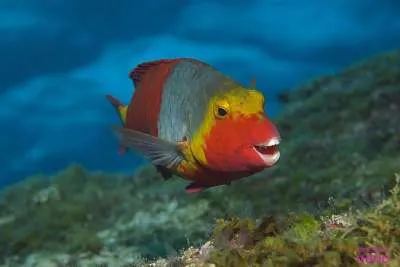
Parrot Fish (Sparisoma Cretense): Did you know that Parrot Fish actually start out in life as a female and can later change to become a male?
Queen Trigger Fish (Balistes Vetula): Queen Trigger Fish can change colour depending on its mood. This feisty fish is known for being very territorial and has no issues seeing off a diver that has strayed too close to its lair!
Guinean Pufferfish (Sphoeroides Marmoratus): Very common to our waters and found in shallow depths, they can grow to over 20 inches. They live amongst the rocky outcrops and can inflate themselves when they feel threatened to deter their predators!
Atlantic Lizardfish (Synodus Saurus): These bottom dwellers like to bury themselves in the sand so that only their heads are visible as they lie in wait for their passing prey!
Red Lip Blenny (Ophioblennius Atlanticus): The Red Lip Blenny is very territorial and likes to hide in between the rocks and crevices. They have elongated bodies and can be found in shallow waters
Scorpion Fish (Scorpaena Scrofa): Scorpion fish are very well camouflaged. They feed mostly on small fish and crustaceans.
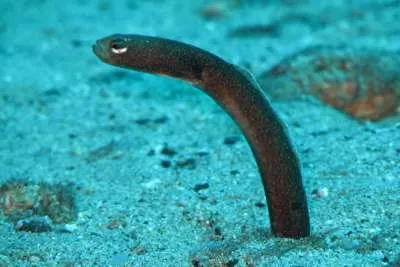 Garden Eel (Heteroconger Longissimus): Part of the Conger family, Garden Ells live in colonies half buried in the sand. They shoot down their burrows if they perceive a threat.
Garden Eel (Heteroconger Longissimus): Part of the Conger family, Garden Ells live in colonies half buried in the sand. They shoot down their burrows if they perceive a threat.
Arrow Crabs (Stenorhynchus Lanceolatus): Their eight legs are extremely long and thin, growing more than three times longer than their bodies. The heads are very pointed, making them look like they are not from this planet! They are nocturnal feeders and like to hide in the crevices of the reefs.
Giant Doris (Felimore Picta): This colourful Sea Slug or Nudibranch grows up to 8 inches long and feeds mainly on sponges
Pink Flabellina (Flabellina Affinis): A species of the Sea Slug family, this pretty little Nudibranch grows to around 50mm and as the name suggests, is a lovely pink in colour.
Spotted Sea Hare (Aplysia Dactylomela): The Spotted Sea Hare is a large species of Sea Slug and is usually found in rocky crevices and shallow water. It can both swim and crawl and squirt ink if disturbed. It has toxins in its skin that make it inedible to most predators.
Roncadores (Umbrina Roncadores): These fish can be seen in super huge shoals of up to a thousand or more. A truly mesmerising sight to behold!
Seahorses (Hippocampus): Though rare, these stunning little creatures can be found on reefs clinging to the local flora. They are exceptionally well camouflaged and shy, so you can deem yourself very honoured if you are lucky enough to spot one!